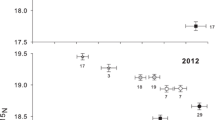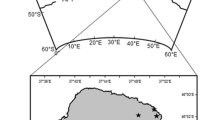Abstract
A growing number of studies suggest that an individual’s physiology affects its carbon and nitrogen stable isotope signatures, obscuring a signal often assumed to be only a reflection of diet and foraging location. We examined effects of growth and moderate food restriction on red blood cell (RBC) and feather δ15N and δ13C in rhinoceros auklet chicks (Cerorhinca monocerata), a piscivorous seabird. Chicks were reared in captivity and fed either control (75 g/day; n = 7) or ~40% restricted (40 g/day; n = 6) amounts of high quality forage fish. We quantified effects of growth on isotopic fractionation by comparing δ15N and δ13C in control chicks to those of captive, non-growing subadult auklets (n = 11) fed the same diet. To estimate natural levels of isotopic variation, we also collected blood from a random sample of free-living rhinoceros auklet adults and chicks in the Gulf of Alaska (n = 15 for each), as well as adult feather samples (n = 13). In the captive experiment, moderate food restriction caused significant depletion in δ15N of both RBCs and feathers in treatment chicks compared to control chicks. Growth also induced depletion in RBC δ15N, with chicks exhibiting lower δ15N when they were growing the fastest. As growth slowed, δ15N increased, resulting in an overall pattern of enrichment over the course of the nestling period. Combined effects of growth and restriction depleted δ15N in chick RBCs by 0.92‰. We propose that increased nitrogen-use efficiency is responsible for 15N depletion in both growing and food-restricted chicks. δ15N values in RBCs of free-ranging auklets fell within a range of only 1.03‰, while feather δ15N varied widely. Together, our captive and field results suggest that both growth and moderate food restriction can affect stable isotope ratios in an ecologically meaningful way in RBCs although not feathers due to greater natural variability in this tissue.



Similar content being viewed by others
References
Barnes C, Sweeting CJ, Jennings S, Barry JT, Polunin NVC (2007) Effect of temperature and ration size on carbon and nitrogen stable isotope fractionation. Funct Ecol 21:356–362
Bearhop SB, Waldrons S, Votier SC, Furness RW (2002) Factors that influence assimilation rates and fractionation of nitrogen and carbon stable isotope signatures in avian blood and feathers. Physiol Biochem Zool 75:451–458
Bearhop S, Phillips RA, McGill R, Cherel Y, Dawson DA, Croxall JP (2006) Stable isotopes indicate sex-specific foraging and long-term individual foraging specialization in diving seabirds. Mar Ecol Prog Ser 311:157–164
Bertram DF, Kaiser GW, Ydenberg RC (1991) Patterns in the provisioning and growth of nestling rhinoceros auklets. Auk 108:842–852
Carleton SA, Martinez del Rio C (2005) The effect of cold-induced increased metabolic rate on the rate of 13C and 15N incorporation in house sparrows (Passer domesticus). Oecologia 144:226–232
Cherel Y, Hobson KA, Guinet C, Vanpe C (2007) Stable isotopes document seasonal changes in trophic niches and winter foraging individual specialisation in diving predators from the Southern Ocean. J Anim Ecol 76:826–836
Cherel Y, Hobson KA, Bailleul F, Groscolas R (2005) Nutrition, physiology, and stable isotopes: new information from fasting and molting penguins. Ecology 86:2881–2888
Cherel Y, Hobson KA, Weimerskirch H (2000) Using stable-isotope analysis of feathers to distinguish moulting and breeding origins of seabirds. Oecologia 122:155–162
Clark RG, Hobson KA, Wassenaar LI (2006) Geographic variation in the isotopic (δD, δ13C, δ15N, δ34S) composition of feathers and claws from lesser scaup and northern pintail: implications for studies of migratory connectivity. Can J Zool 84:1395–1401
DeNiro MJ, Epstein S (1977) Mechanism of carbon isotope fractionation associated with lipid synthesis. Science 197:261–263
Durant JM, Stenseth NC, Anker-Nilssen T, Harris MP, Thompson PM, Wanless S (2004) Marine birds and climate fluctuation in the North Atlantic. In: Stenseth NC, Ottersen G, Hurrell JW, Belgrano A (eds) Marine ecosystems and climate variation: the North Atlantic. Oxford University Press, Oxford, pp 95–105
Evans-Ogden LJ, Hobson KA, Lank DB (2004) Blood isotopic (δ13C and δ15N) turnover and diet-tissue fractionation in captive dunlin (Calidris alpina pacifica). Auk 121:170–177
Fantle MS, Dittel AI, Schwalm SM, Epifanio CE, Fogel ML (1999) A food web analysis of the juvenile blue crab, Callinectes sapidus, using stable isotopes in whole animals and individual amino acids. Oecologia 120:416–426
Folch J, Lees M, Stanley GHS (1957) A simple method for the isolation and purification of total lipids from animal tissues. J Biol Chem 226:497–509
Forero MG, Hobson KA, Bortolotti GR, Donazar JA, Bertelloti M, Blanco G (2002) Food resource utilisation by the Magellanic penguin evaluated through stable isotope analysis: segregation by sex and age and influence on offspring quality. Mar Ecol Prog Ser 234:289–299
Forero MG, Gonzalez-Solis J, Hobson KA, Donazar JA, Bertelloti M, Blanco G, Bortolotti GR (2005) Stable isotopes reveal trophic segregation by sex and age in the southern giant petrel in two different food webs. Mar Ecol Prog Ser 296:107–113
Fuller BT, Fuller JL, Sage NE, Harris DA, O’Connell TC, Hedges RE (2005) Nitrogen balance and δ15N: why you’re not what you eat during nutritional stress. Rapid Commun Mass Spectr 19:2497–2506
Fuller BT, Fuller JL, Sage NE, Harris DA, O’Connell TC, Hedges REM (2004) Nitrogen balance and δ15N: why you’re not what you eat during pregnancy. Rapid Commun Mass Spectr 18:2889–2896
Gannes LZ, O’Brien DM, Martinez del Rio C (1997) Stable isotopes in animal ecology: assumptions, caveats, and a call for more laboratory experiments. Ecology 78:1271–1276
Gannes LZ, Martinez del Rio C, Koch P (1998) Natural abundance variations in stable isotopes and their potential uses in animal physiological ecology. Comp Biochem Physiol 119:725–737
Gaston AJ, Dechesne SB (1996) Rhinoceros Auklet (Cerorhinca monocerata). In: Poole A, Gill F (eds) The birds of North America, vol 212. The Birds of North America, Philadelphia
Gaye-Siessegger J, Focken U, Abel H, Becker K (2004a) Individual protein balance strongly influences δ15N and δ13C values in Nile tilapia, Oreochromis niloticus. Naturwissenschaften 91:90–93
Gaye-Siessegger J, Focken U, Muetzel S, Abel H, Becker K (2004b) Feeding level and individual metabolic rate affect δ13C and δ15N values in carp: implications for food web studies. Oecologia 138:175–183
Gjerdrum C (2004) Parental provisioning and nestling departure decisions: a supplementary feeding experiment in tufted puffins (Fratercula cirrhata) on Triangle Island, British Columbia. Auk 121:463–472
Gladbach A, McGill RA, Quillfeldt P (2007) Foraging areas of Wilson’s storm-petrel Oceanites oceanicus in the breeding and inter-breeding period determined by stable isotope analysis. Polar Biol 30(8):1005–1012. doi:10.1007/s00300–007-0258-2
Hedd A, Montevecchi WA (2006) Diet and trophic position of Leach’s storm-petrel Oceanodroma leucorhoa during breeding and moult, inferred from stable isotope analysis of feathers. Mar Ecol Prog Ser 322:291–301
Hobson KA, Alisauskas RT, Clark RG (1993) Stable-nitrogen isotope enrichment in avian tissues due to fasting and nutritional stress: implications for isotopic analyses of diet. Condor 95:388–394
Hobson KA, Piatt JF, Pitocchelli J (1994) Using stable isotopes to determine seabird trophic relationships. J Anim Ecol 63:786–798
Hodum PJ, Hobson KA (2000) Trophic relationships among Antarctic fulmarine petrels: insights into dietary overlap and chick provisioning strategies inferred from stable-isotope (δ15N and δ13C) analyses. Mar Ecol Prog Ser 198:273–281
Kempster B, Zanette L, Longstaffe FJ, MacDougall-Shackleton SA, Wingfield JC, Clinchy M (2007) Do stable isotopes reflect nutritional stress? Results from a laboratory experiment on song sparrows. Oecologia 151:365–371
Koch PL (2007) Isotopic study of the biology of modern and fossil vertebrates. In: Lajtha K, Michener R (eds) Stable isotopes in ecology and environmental science. Blackwell, Oxford, pp 63–92
Macko SA, Fogel Estep ML, Engel MH, Hare PE (1986) Kinetic fractionation of stable nitrogen isotopes during amino acid transamination. Geochim Cosmochim Acta 50:2143–2146
Martinez del Rio C, Wolf B (2005) Mass-balance models for animal ecology. In: Stark JM, Wang T (eds) Physiological and ecological adaptations to feeding in vertebrates. Science Publishers, Enfield, New Hampshire, pp 141–174
Minigawa M, Wada E (1984) Stepwise enrichment of δ15N along food chains: further evidence and the relationship between δ15N and animal age. Geochim Cosmochim Acta 48:1135–1140
Ponsard S, Averbuch P (1999) Should growing and adult animals fed on the same diet show different δ15N values. Rapid Comm Mass Spectr 13:1305–1310
Romano M (2000) Effects of diet on growth and development of seabird nestlings. M.Sc. Thesis, Oregon State University, Corvallis
SAS (2001) SAS Institute, Cary, NC
Sweeting CJ, Polunin NVC, Jennings S (2006) Effects of chemical lipid extraction and arithmetic lipid correction on stable isotope ratios of fish tissues. Rapid Commun Mass Spectr 20:595–601
Thompson DR, Lilliendahl K, Solmundsson J, Furness RW, Waldron S, Phillips RA (1999) Trophic relationships among six species of Icelandic seabirds as determined through stable isotope analysis. Condor 101:898–903
Trueman CL, McGill RAR, Guyard PH (2005) The effect of growth rate on tissue-diet isotopic spacing in rapidly growing animals: an experimental study with Atlantic salmon (Salmo salar). Rapid Commun Mass Spectr 19:3239–3247
Williams CT, Buck CL, Sears J, Kitaysky AS (2007) Effects of nutritional restriction on nitrogen and carbon stable isotopes in growing seabirds. Oecologia 153(1):11–18. doi:10.1007/s00442–007-0717-z
Acknowledgments
We thank the 2006 and 2007 Middleton Island crews for egg collection and assistance in the field, and T. Howe and N. Haubenstock at the Alaska Stable Isotope Facility who performed isotopic analysis. We also thank R. Lord, C. Williams, M. Schultz, M. Benowitz-Fredericks, A. Keech, J. Brewer and the UAF Animal Quarters staff for help rearing and bleeding chicks. The captive portion of the study was supported by a grant from the UAF Institute of Arctic Biology to A. S. Kitaysky. The US Geological Survey, Alaska Science Center covered field costs. J.S. was supported by a graduate fellowship from Alaska EPSCoR and a grant from the Angus Gavin Memorial Bird Research Fund, which also covered all costs of stable isotope analysis. A. Powell, C. Williams, S. Oppel, and two anonymous reviewers provided many helpful comments on earlier versions of this manuscript. All captive and field procedures were approved by UAF IACUC (Assurance # 07–28). The use of trade, firm, or corporation names in this publication is for the convenience of the reader. Such use does not constitute an official endorsement or approval by the US Government of any product or service to the exclusion of others that may be suitable.
Author information
Authors and Affiliations
Corresponding author
Additional information
Communicated by Jacek Radwan.
Rights and permissions
About this article
Cite this article
Sears, J., Hatch, S.A. & O’Brien, D.M. Disentangling effects of growth and nutritional status on seabird stable isotope ratios. Oecologia 159, 41–48 (2009). https://doi.org/10.1007/s00442-008-1199-3
Received:
Accepted:
Published:
Issue Date:
DOI: https://doi.org/10.1007/s00442-008-1199-3




